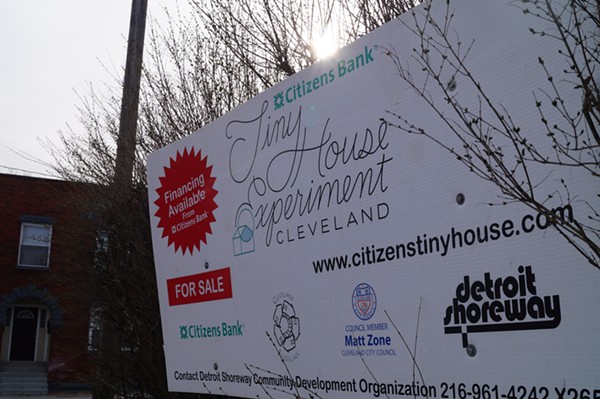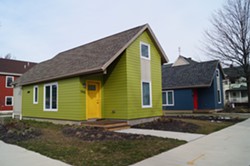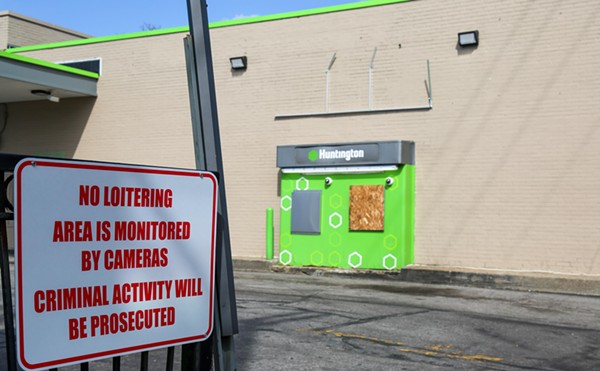That "Tiny House Experiment" in Detroit Shoreway Pretty Much Failed
By Sam Allard on Fri, Mar 17, 2017 at 12:10 pm
[
{
"name": "Ad - NativeInline - Injected",
"component": "38482495",
"insertPoint": "3",
"requiredCountToDisplay": "5"
},{
"name": "Real 1 Player (r2) - Inline",
"component": "38482494",
"insertPoint": "2/3",
"requiredCountToDisplay": "9"
}
]
Despite fanfare and early confidence, Cleveland's "Tiny House Experiment" appears to have failed. Two heavily-marketed, energy-efficient small homes built last year on the corner of W. 58th and Pear Avenue in the Detroit Shoreway neighborhood were ultimately sold to the project's builder, Keith Sutton, who is now thought to be renting the properties until the market sufficiently ripens for a sale.
The two houses, 583 and 628 square feet respectively, were a collaborative effort between the Detroit Shoreway Community Development Organization (DSCDO), Citizens Bank and Sutton Development.
The two tax-abated properties were initially listed at $129,000 and $149,000, but top realtors at both Howard-Hanna and Progressive Urban Real Estate failed to lure buyers.
Mark Lastition is a realtor in Howard-Hanna's W. 25th Street office. He admitted he was surprised by the lack of interest.
"People liked the idea, but no one pulled the trigger," he commented on a thread in the Detroit-Shoreway Community Facebook page this week. "Seems that 'tiny houses' are trendy to talk about - just not trendy to buy."
Lastition, who didn't work directly on the project, has been an Ohio City resident since 1993. He elaborated on his comments in a phone conversation with Scene Thursday.
"I'm as eager as the next person to see affordable, alternative housing options put up that may be marketed to a different audience," Lastition said. "So it's frustrating when you see a well-respected CDC like Detroit Shoreway put together this plan and the financing, with a builder who's entirely on board, and nobody salutes."
Lastition said "everybody and their brother" wanted to take a look at the houses when they first came on the market and that there was no consistent theme from buyers, other than their ultimate ambivalence. The homes were well-built, well-executed, and enormously efficient. (Yearly utility payments might be as low as $500.)
"But people would say, 'for $129,000, there's any number of homes I could buy,'" Lastition recalled. "Well, that's true. But they're not what these houses are about."
Lastition said there was at least one buyer who'd wanted to buy one of the homes as an investment property, but due to financing restrictions from Citizens Bank, who contributed funds for the design and marketing work, that wasn't an option.
According to observers on the Facebook thread, the homes occupied a middle ground that may have made them less attractive for some buyers.
"It's a difficult balancing act where the novelty of an efficient tiny house needs to match the appeal of much larger, neighboring housing stock," wrote Jonathan Sheirer. "These are a bit too big and expensive to be actual tiny houses, and I feel that the design intent to keep them "tiny house-esque" ended up sacrificing some of the potential for them to just be small, energy-efficient houses."
To those who thought the price point was a bit too steep, Lastition chimed in on the thread to say that energy-efficient new construction projects are expensive, and the homes couldn't have been sold for much less.
DSCDO's Adam Davenport, who managed the project, confirmed.
"Whether it's 400 square feet or 4,000 square feet, energy efficiency utility hookups are just really expensive," he said.
Davenport also said that there had been a few offers on the houses, but that they came in too low, and DSCDO didn't want to undersell.
"The purpose of the project was to meet our EcoVillage values," Davenport told Scene, "We really wanted that energy-efficiency component; we wanted an aging in place friendly house; and we wanted some semblance of a yard on this formerly vacant city lot. These are pretty different than the 200-square-foot tiny houses that you see on TV."
Davenport said that DSCDO rented out one of the homes as an AirBNB for about two-and-a-half months last year — guests included City Councilman Matt Zone and folks from Snapchat during the RNC — but that ultimately the development organization decided to sell to Sutton, whom Davenport called a "good landlord."
Sutton works primarily in Tremont, having done construction on the Bergen Place and Starkweather Place projects there. Last year, he told Michelle Jarboe at The Plain Dealer that he was "totally smitten" by the Tiny House concept, and was hoping to use the Detroit Shoreway experiment as a model to duplicate.
When Scene reached Sutton by phone Friday, he said he had no comment on the project or his future plans.
Councilman Matt Zone, who was enthusiastic about the Tiny House Experiment at a ribbon-cutting last year and who has expressed confidence in the neighborhood's appetite for tiny houses, wasn't immediately available for comment.
Mark Lastition thinks there's still hope for alternative housing options on the near west side.
"It's just finding someone who's willing to be innovative," he said. "And sadly, we don't have a great track record. If any community was going to be forward-thinking about how this all could happen, I would've guessed that it was going to be Detroit Shoreway."
The two houses, 583 and 628 square feet respectively, were a collaborative effort between the Detroit Shoreway Community Development Organization (DSCDO), Citizens Bank and Sutton Development.
The two tax-abated properties were initially listed at $129,000 and $149,000, but top realtors at both Howard-Hanna and Progressive Urban Real Estate failed to lure buyers.
Mark Lastition is a realtor in Howard-Hanna's W. 25th Street office. He admitted he was surprised by the lack of interest.
"People liked the idea, but no one pulled the trigger," he commented on a thread in the Detroit-Shoreway Community Facebook page this week. "Seems that 'tiny houses' are trendy to talk about - just not trendy to buy."
Lastition, who didn't work directly on the project, has been an Ohio City resident since 1993. He elaborated on his comments in a phone conversation with Scene Thursday.
"I'm as eager as the next person to see affordable, alternative housing options put up that may be marketed to a different audience," Lastition said. "So it's frustrating when you see a well-respected CDC like Detroit Shoreway put together this plan and the financing, with a builder who's entirely on board, and nobody salutes."
Lastition said "everybody and their brother" wanted to take a look at the houses when they first came on the market and that there was no consistent theme from buyers, other than their ultimate ambivalence. The homes were well-built, well-executed, and enormously efficient. (Yearly utility payments might be as low as $500.)
"But people would say, 'for $129,000, there's any number of homes I could buy,'" Lastition recalled. "Well, that's true. But they're not what these houses are about."
Lastition said there was at least one buyer who'd wanted to buy one of the homes as an investment property, but due to financing restrictions from Citizens Bank, who contributed funds for the design and marketing work, that wasn't an option.
According to observers on the Facebook thread, the homes occupied a middle ground that may have made them less attractive for some buyers.
"It's a difficult balancing act where the novelty of an efficient tiny house needs to match the appeal of much larger, neighboring housing stock," wrote Jonathan Sheirer. "These are a bit too big and expensive to be actual tiny houses, and I feel that the design intent to keep them "tiny house-esque" ended up sacrificing some of the potential for them to just be small, energy-efficient houses."
To those who thought the price point was a bit too steep, Lastition chimed in on the thread to say that energy-efficient new construction projects are expensive, and the homes couldn't have been sold for much less.
DSCDO's Adam Davenport, who managed the project, confirmed.
"Whether it's 400 square feet or 4,000 square feet, energy efficiency utility hookups are just really expensive," he said.
Davenport also said that there had been a few offers on the houses, but that they came in too low, and DSCDO didn't want to undersell.
"The purpose of the project was to meet our EcoVillage values," Davenport told Scene, "We really wanted that energy-efficiency component; we wanted an aging in place friendly house; and we wanted some semblance of a yard on this formerly vacant city lot. These are pretty different than the 200-square-foot tiny houses that you see on TV."
Davenport said that DSCDO rented out one of the homes as an AirBNB for about two-and-a-half months last year — guests included City Councilman Matt Zone and folks from Snapchat during the RNC — but that ultimately the development organization decided to sell to Sutton, whom Davenport called a "good landlord."
Sutton works primarily in Tremont, having done construction on the Bergen Place and Starkweather Place projects there. Last year, he told Michelle Jarboe at The Plain Dealer that he was "totally smitten" by the Tiny House concept, and was hoping to use the Detroit Shoreway experiment as a model to duplicate.
When Scene reached Sutton by phone Friday, he said he had no comment on the project or his future plans.
Councilman Matt Zone, who was enthusiastic about the Tiny House Experiment at a ribbon-cutting last year and who has expressed confidence in the neighborhood's appetite for tiny houses, wasn't immediately available for comment.
Mark Lastition thinks there's still hope for alternative housing options on the near west side.
"It's just finding someone who's willing to be innovative," he said. "And sadly, we don't have a great track record. If any community was going to be forward-thinking about how this all could happen, I would've guessed that it was going to be Detroit Shoreway."
SCENE Supporters make it possible to tell the Cleveland stories you won’t find elsewhere.
Become a supporter today.
About The Author
Sam Allard
Sam Allard is the Senior Writer at Scene, in which capacity he covers politics and power and writes about movies when time permits. He's a graduate of the Medill School of Journalism at Northwestern University and the NEOMFA at Cleveland State. Prior to joining Scene, he was encamped in Sarajevo, Bosnia, on an...
Scroll to read more Cleveland News articles
Newsletters
Join Cleveland Scene Newsletters
Subscribe now to get the latest news delivered right to your inbox.














